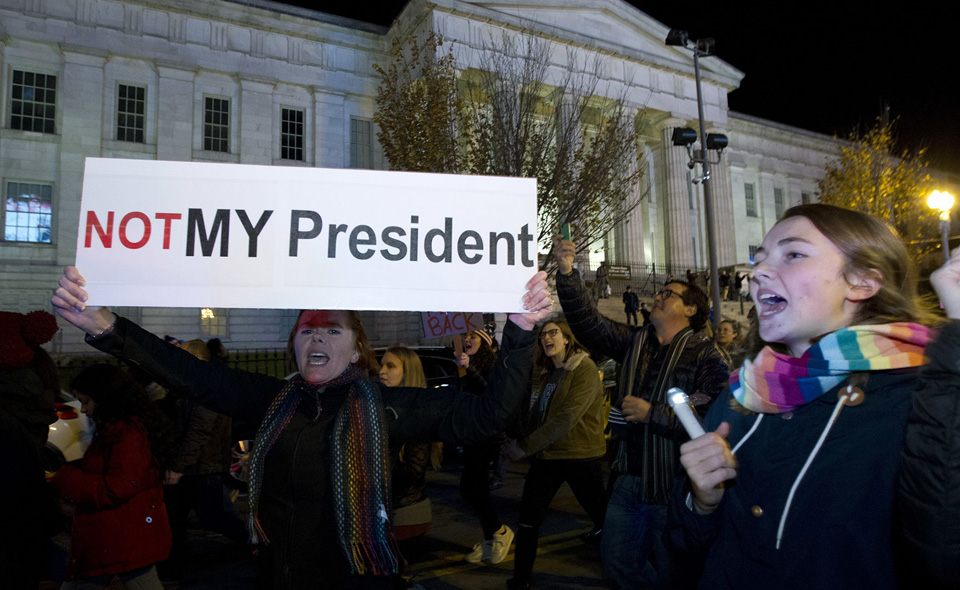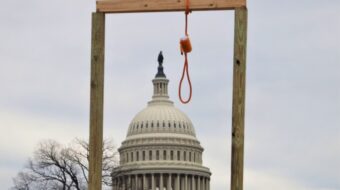
In this, the second of three articles he has written on the election, People’s World contributor Marc Brodine takes a page from the anti-fascist struggles of the past and examines what’s needed to build a broad, united resistance in our own time. Part 1 can be read here. Part 3 will appear shortly.
During the long primary and election campaigns of 2016, it became clear that few if any of the old political rules apply anymore. We need to take a long and detailed look at the 2016 elections in order to develop the best strategy to resist the unconstitutional attacks that Trump is already proclaiming. We need to build coalitions and movements, both short-term on specific issues and long-term on wide-ranging fronts. We also need to learn from history, including from the anti-fascist struggles of the last century. This is the second in a three-part series taking a look at some of these issues.
Lessons from history
The experiences of the Communist, socialist, and democratic resistance to fascism during the 1930s in Europe, and of fighting fascism in Chile in the 1970s and 1980s, offer important lessons for us today.

Summing up some of those lessons, Georgi Dimitrov in his 1935 speech to the Seventh World Congress of the Communist International, talked about building a broad front of all those who opposed fascism, about confronting fascist ideology, and the necessity of overcoming sectarian obstacles to left and democratic unity.
Dimitrov noted that, “One of the weakest aspects of the anti-fascist struggle of the Communist Parties is that they react inadequately and too slowly to the demagogy of fascism, and to this day continue to neglect the problems of the struggle against fascist ideology. Many comrades did not believe that so reactionary a brand of bourgeois ideology as the ideology of fascism, which in its stupidity frequently reaches the point of lunacy, would be able to gain any mass influence. This was a serious mistake. The putrefaction of capitalism penetrates to the innermost core of its ideology and culture, while the desperate situation of wide masses of the people renders certain sections of them susceptible to infection from the ideological refuse of this putrefaction.”
This describes exactly the situation in which we now find ourselves. Lunatic policy proposals, incoherent proclamations and tweets, nominations and appointments of patently incompetent people, and foaming-at-the-mouth advisors from the ultra-right fringe.
The challenge to us is political, but it is also ideological. Attacking racists, racist actions, and racist policies must be accompanied by an attack on racism itself – on the ideological underpinnings of the “white nationalist” movement. Even as we reject the idea that racism by itself is the only explanation for the Trump victory, we must prevent further efforts to win even more white workers to fully support racism.
Some on the left fringe glory in every story of left-wing bullies beating up right-wing bullies. They confuse “fighting fascism” with physical violence, ignoring two important realities.
First, fighting fascism will take many forms, most of them explicitly ideological and political. Most of those will be non-violent. Furthermore, the appeal of the pro-democracy forces will, at least at this stage, depend on non-violence.
Second, in Germany before Hitler’s rise to power, the left had “street-fighting” militias, who regularly warred with fascist gangs in the streets of Berlin and other major German cities. They did not stop fascism. Fascism must be defeated politically – and the time to do so is short. So far in history, fascism in power has been defeated only through foreign military intervention (World War II), the death of the fascist leader (Spain and Portugal), or after many decades of internal and international pressure (Chile and Greece).
This is not to advocate laying down in the face of racist and sexist attacks, of hate crimes and swastika-painting, of bullies in our public spaces, but it is to argue that we should not confuse resistance and solidarity with pugilism.
The real shift in power and initiative
While there was no significant shift among voters nationwide, and facile claims of such trends do a disservice, that does not mean there haven’t been significant shifts. The real, most dangerous shift is in political power and initiative.
Republicans now control the Presidency and both houses of Congress, as well as nominations for the Supreme Court and other branches of the Federal judiciary. Additionally, Republicans now control a majority of state governorships and state legislative bodies. This opens the possibilities of serious efforts to shift the rules of elections away from more inclusion and democracy.
Trump’s rhetoric and policies will continue to be uniquely American, tailoring his message to U.S. sensibilities and U.S. issues, wrapping himself in the flag and in at best insubstantial patriotic rhetoric.
Based on our experiences of the Reagan and Bush administrations, what can we expect, beyond the speculation about implementing Trump’s anti-immigrant, anti-women policies?
- We can expect a huge increase in corruption, both hidden and overt.
- We can expect a huge uptick in incompetence throughout the administration. This on top of the distressing reality that many of Trump’s Cabinet members will have the explicit job of destroying the departments they will head.
- We can predict that Trump will do the opposite of what he promised on the campaign trail in most economic policy areas.
Those who take solace in the institutional checks and balances of the U.S. Constitutional system would do well to remember the actions of Republican state officials all over the country after the Supreme Court gutted the Voting Rights Act.
Within days (in some cases, hours) of that decision, at least ten states proposed laws or plans to implement policies to suppress the vote: from voter ID requirements to gerrymandering to eliminating many early voting days to closing many polling places in poor, working class, and African American communities. Since then, many have also instigated specious “purges” of the voting rolls based on little or no evidence.
Remember (or research) how quickly newly-elected Republican state officials propose anti-democratic, anti-women’s health measures as soon as they take office – even those supposedly “sane, reasonable” anti-Trump Republicans like Ohio Governor Kasich, who has cut funding for women’s health, proposed (unsuccessfully) destroying many union rights in his state, and supported a Secretary of State who has made many attempts (some reversed by federal courts) to suppress the vote of workers, African Americans, Latinos, and poor people.
Or look at the state of Kansas under Governor Brownback, with his self-proclaimed “experiment” in Republican economics. His policies are destroying the state budget and state-wide public education, among other despicable initiatives.
We can also expect stepped-up efforts to revive full-throated anti-communism, redbaiting, and blacklisting. This will be added to the already toxic stew of racism, misogyny, xenophobia, and overt fascism.
Disgust by some at the increased incompetence and corruption opens the possibility of including some Republicans in the anti-Trump movement. This will likely not include many from the Republican political class, as evidenced by Mitt Romney’s flirtation with Trump (after denouncing him!). But it could potentially include some from the mass of Republican and Republican-leaning voters.
Before you dismiss this possibility, remember how horrified many Republicans were at the incompetence of the Bush administration. This was a noticeable factor in the 2006 and 2008 Democratic wave elections.
Already, there are the signs of some continuing splits in the ruling class. Many Republicans in Congress are of course uniting behind Trump and plan to ride on his partial victory to impose their own policy prescriptions. Paul Ryan is again pushing proposals to gut Medicaid, Medicare, and Social Security through budget cuts, privatization, and underfunded block grants to states.
While we should not place any hope in quick or decisive opposition from sections of the ruling class, it should be obvious even for many CEOs that Trump will favor and privilege developers, real estate interests, fossil fuel companies, and the financial sector over businesses that depend on direct consumer spending. This will lead to increasing conflict within the ruling class, opening fault lines that a left-center movement could take advantage of; they represent opportunities for expanding the alliance beyond traditional political boundaries.
The international right-wing threat
There are very disturbing international implications to Trump’s appointment of Steve Bannon as strategist-in-chief. In addition to worries about militarism, temperament issues, and lack of any diplomatic skills, we should add the worry that Bannon’s stated aim is to build alliances with ultra-right movements around the world, starting with Europe.
Breitbart News is opening branches in France and Germany as part of this goal. Trump’s election has already emboldened the ultra-right in Europe in much the same way it has fascists, “white nationalists,” the KKK, and others in our country. This portends poorly for peace in many parts of the world. It is not that all ultra-right nationalists will have the same aims. Rather, the concern is that their propensity for adventurism distracts from the hollowness of their promises to workers and will lead to instability, dangerous conflicts, and military confrontations.
The ultra-right in the U.S. becomes the excuse for the ultra-right in Europe, and the anti-Muslim proclamations and policies of the ultra-right in the U.S. and Europe become the excuse for a further escalation by the ultra-right in the Middle East. In an endless loop of endless war and terrorism, each action and reaction provide more ammunition – a self-reinforcing process.
We can, unfortunately, confidently predict that the Trump administration will use any new terrorist attacks anywhere in the world to whip up anti-Muslim hysteria, build support for his anti-democratic proposals, and divert attention from his anti-people programs.
Trump’s election has already helped encourage and energize the ultra-right in Europe. Right-wing electoral gains have been occurring across that continent over the last few decades, but they now seem to be reaching a critical mass. The alliance between European right-wing parties and the Trump coalition threatens the peace of the world, as well as the social and economic gains that workers have won over many decades of struggle. It speaks to the reality that the “Trump phenomenon” is not something limited to the United States. It is inherent in the current phase of capitalist political development and will require an international response from working class and progressive parties everywhere.
Building the resistance
The right wing is now continuing attacks they have made over the past few years to limit or eliminate institutions that have the capacity to resist. Attacks on union rights and the right of unions to participate in the political process, the destruction of ACORN, attacks on Planned Parenthood, and other such measures are often falsely justified on grounds meant to garner support from the right-wing base. But they are also intended to make it more difficult for the left and center forces to oppose Republican policies.
These attacks on progressive institutions are not separate from each other. Groups such as ALEC (American Legislative Exchange Council) coordinate these campaigns, draft legislation and regulations for right-wing officials in many states, and try to stay behind the scenes so the public doesn’t recognize these attacks in individual states as part of a nationwide strategy.
The coalitions, alliances, and movements we need have many aspects: developing strategy, increasing organizational resources, strengthening the institutional capacity to maintain resistance over a protracted period, fighting defensive battles, and whenever possible waging positive struggles for real solutions,
Building a broad and wide-ranging resistance is not the work of a few days or weeks. It requires not only comprehending reality in a detailed way, but also understanding the different forces which can impact the coalitions we need to build, who are essential allies, and who are temporary or partial allies.
It is the job of the left – and of the center and even some conservative forces and groups – to build a resistance strong enough, broad enough, and persistent enough to defeat attacks on democracy and on the democratic space for ongoing protest and opposition.
The fight for democracy is one of the broadest fields on which to wage the struggle against Trump, and it draws on the long U.S. history of the constant fight to expand the electorate. These struggles protect our ability and our rights to continue waging these battles in the future. If the right can criminalize protest, they can restrict our right to stop them, to wage campaigns for public opinion, to engage in civil disobedience, to petition for redress of grievances, and to exercise our right to free speech.
Berlusconi or Hitler?
As we prepare to resist what promises to be a tsunami of right-wing legislative efforts in the first 100 days of the Trump administration, we face the question: what exactly we need to prepare for?
Will Trump end up being a Berlusconi, a Mussolini, or a Hitler? Is a bumbling, corrupt, incompetent administration in the works? Or is this the early sign of not just fascist activism (already seen in many places) but of full-blown anti-democratic fascism? Do we need to be prepared for the destruction of the Constitution, complete with internment camps, abrogations of all civil rights protections and democratic norms – in the words of Dimitrov again, an open terrorist dictatorship of the most reactionary ruling circles?
The real answer to this question comes not from any pseudo-psychological guesswork into Trump’s distorted and disordered personality, but rather from the resistance we create. The strength of that resistance is the main factor in determining our future.
Trump and the people around him (Bannon, for example) can be as fascist as they want inside their own heads. Trump’s obvious megalomania and egomaniacal power-hunger can be as out-of-control as possible in his own fevered imagination. But no matter what is in his head or those of the coterie of right-wing loonies he is surrounding himself with, politics in the real world will determine the course of events. Trumps’ narcissism and obsessive attention to the media obviously play a role in public perception of him.
However, that is only a small piece of the political puzzle his election has created. We should have no illusions about what the Trump grouping wants, or about imagined limitations on their power. When Allende was elected in Chile, many Chileans, though worried about the warning signs of a fascist coup, placed too much faith in the long history of constitutional government, the peaceful transition of power, and the pledge of the military to stay out of politics. Fascists are not respecters of tradition, of democratic norms and practices, no matter what they spew for public consumption.
But their actions and attacks do not happen in a vacuum. Bush’s Vice-President Dick Cheney was clearly a fascist, but could not get away with everything he would have liked to. That was not due to any restraint on his part, but due to the opposition his policies elicited.
To develop the most effective strategy against the policies that Trump and his ilk are already proposing, we must soberly deal with reality. Unfortunately, in discussing the causes of the Trump Electoral College victory, too many pundits, pollsters, commentators, and even left-wing analysts are seizing hold of one or another partial truth and proclaiming that partial truth as “the” explanation. This quick-to-judgement approach does a disservice to the unity of the movement we need to build.
Part 3 of this series will appear on People’s World soon.










